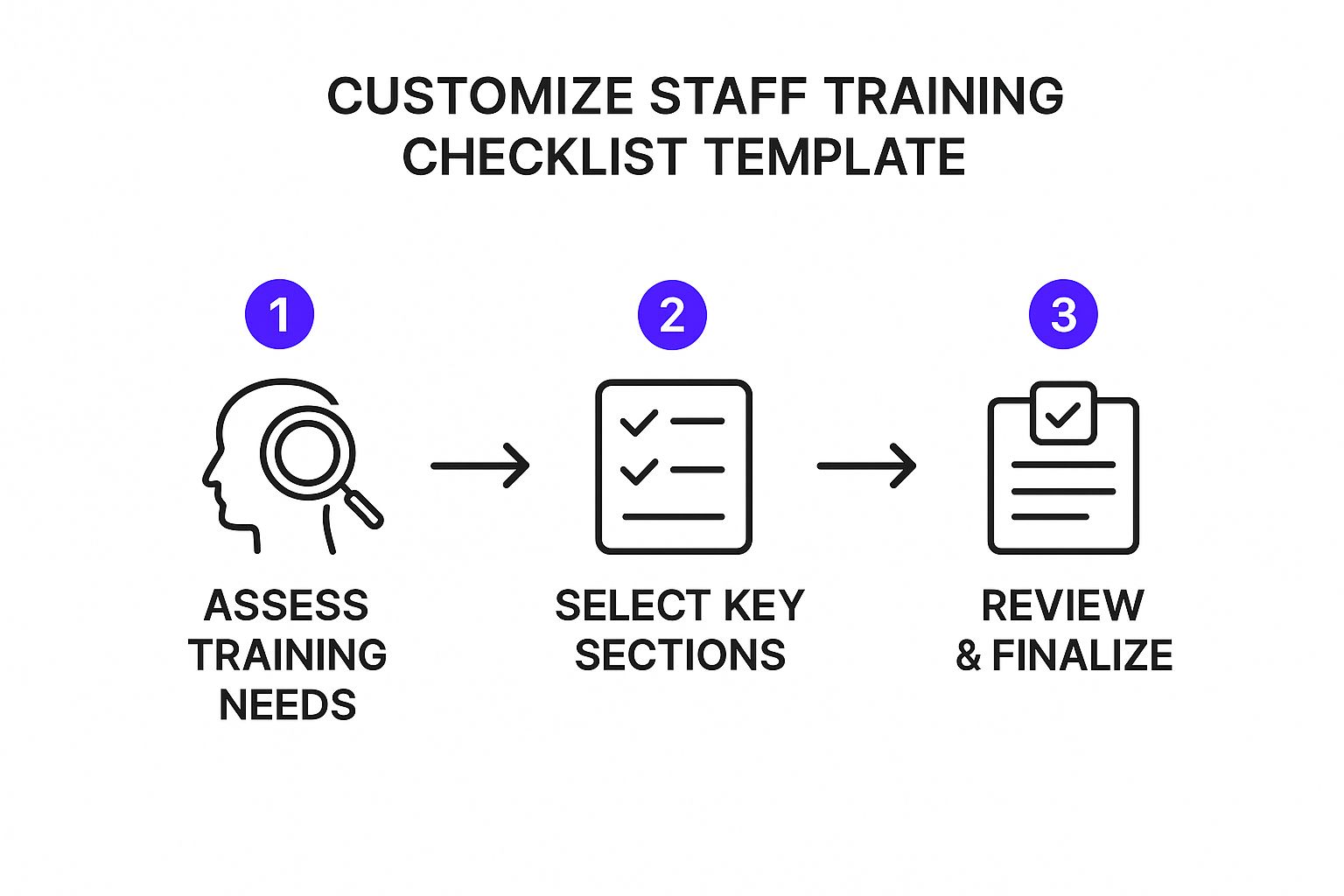Think of a staff training checklist template as your company’s playbook. It’s a structured guide that lays out every single task, skill, and bit of know-how a new or existing employee needs to master. This simple document is what turns a messy, "figure it out as you go" onboarding process into a repeatable system that you can actually measure.
Why Standardized Training Is Your Secret Weapon
Let's stop thinking of training as just "getting new hires up to speed." In a home service business, your technicians are literally the face of your brand. When they're in a customer's home, inconsistent training isn't just a small issue—it's a direct threat to your reputation and your bottom line. If you want to scale your business without chaos, a structured approach using a solid checklist is non-negotiable.
Picture this. You hire two new HVAC techs. One learns by shadowing various senior techs, picking up a mix of good and bad habits along the way. The other follows a detailed checklist, making sure they master safety protocols, customer communication scripts, and your specific technical procedures the exact same way, every single time. The difference is night and day. The second tech makes fewer costly mistakes, delivers a far more professional customer experience, and starts contributing to the team much faster.
The Tangible Impact on Your Business
This isn't just about feeling more organized; it's about seeing real returns. When you invest time into building a structured training system, you get measurable results across the board.
Here's what you can expect:
- Drastically Reduced Errors: A checklist makes sure crucial steps are never forgotten, whether it's remembering to lock a customer's gate or properly testing a system after a repair.
- Improved Customer Satisfaction: Consistent service means every customer gets the high-quality experience you promise. That consistency is what builds trust and racks up those 5-star reviews.
- Increased Profitability: Well-trained teams are just flat-out more efficient and productive. The numbers don't lie—companies with formal training programs see 218% higher income per employee and a 21% boost in profitability.
Take a look at how this structured approach compares to the more common, informal "on-the-job" training.
Checklist Training vs Informal Training
| Business Area | Impact of Checklist-Based Training |
|---|---|
| Consistency | Every technician delivers the same high-quality service, reinforcing your brand promise. |
| Efficiency | New hires become profitable team members faster, reducing the time spent on corrections and oversight. |
| Risk Management | Safety and compliance steps are documented and followed, minimizing liability and on-site accidents. |
| Customer Trust | Homeowners feel more confident when they see a professional, systematic approach to their service. |
| Scalability | You can add new team members or even open a new location without reinventing your training process. |
The benefits are clear. A checklist system gives you a solid foundation to build upon.
The real power of a checklist is that it creates a baseline for performance. It eliminates guesswork and empowers every team member, regardless of their prior experience, to meet your company's standard of excellence from day one.
Ultimately, this structure makes your life as a manager or owner so much simpler. I’ve seen many owners who are reluctant to hire virtual assistants and other support staff because they dread the training process. But when you have a clear checklist, onboarding any role becomes far more straightforward.
To really dig into why this works so well, it's worth learning about the power of checklists and how they apply to team performance.
Building Your Master Training Checklist
Think of your master staff training checklist as the blueprint for your entire team. It's the one document that ensures every single new hire—whether they're an apprentice plumber or a seasoned HVAC tech—learns the core DNA of your business. Before you start listing out every single task, you need to think big picture.
The key is to organize the training into logical phases. This prevents you from overwhelming new employees and makes sure nothing important gets skipped. Here's a simple way to visualize the workflow:

As you can see, you have to understand your needs before you start writing anything down. By first figuring out what skills are actually essential, you can build a template that delivers real results instead of just checking boxes.
Core Training Modules
Every home service business, regardless of the trade, has a few foundational pillars that everyone needs to master. Your master checklist should be built around these. A great first step is to get a clear picture of where your team's skills are right now by using a training needs assessment template to spot any gaps.
Once you know what you're working with, you can structure your checklist around these four essential modules:
-
Company Culture & Values: This is way more than just memorizing a mission statement. I'm talking about checklist items like, "Explain our customer service guarantee in your own words" or "Name three things that make us different from the competition down the street."
-
Job Site Safety Protocols: This one is absolutely non-negotiable. Get specific. Your checklist needs actionable tasks like, "Demonstrate the right way to set up and climb a ladder" or "Identify and put on all required personal protective equipment (PPE)."
-
Core Technical Skills: This is where you break down the hands-on stuff. For a new HVAC apprentice, you might include tasks like, "Walk me through a standard system diagnostic test" and "Show me how to properly clean an AC condenser coil."
-
Customer Communication & Soft Skills: How your team talks to homeowners is just as important as the technical work. Use role-playing scenarios here. For example: "Let's role-play how you'd handle a customer who's upset about the final bill" or "Practice explaining a complex repair in simple, easy-to-understand terms." You can find some great principles for this in our guide at https://phonestaffer.com/virtual-assistant-complete-course/.
The goal isn't just to make a to-do list. You're building a roadmap to competency. Every single item on that checklist should be a skill that a trainer can watch, verify, and sign off on.
This kind of structured training is becoming more critical by the day. Projections for 2030 show that for every 100 workers, 29 will need upskilling and another 19 will need reskilling just to stay current. A well-built, adaptable training checklist is your best tool for keeping your team ahead of the curve.
Customizing Checklists for Different Roles
Your master training template is a fantastic starting point, but let’s be real—a one-size-fits-all checklist just doesn’t cut it in the field. A rookie plumber who’s still learning the difference between PVC and PEX needs a completely different onboarding experience than a seasoned HVAC tech getting up to speed on the latest smart home systems. If you try to train them both with the same document, you'll end up with a process that’s inefficient for the business and frustrating for your team.
The trick is to use your master list as the core curriculum and then create specialized versions for each role. This way, every new hire gets the exact training they need, without being swamped with information they already know or won't use. It’s a modular approach that makes the whole training system more effective and keeps people engaged.
Creating Role-Specific Variations
I like to think of it like building with LEGOs. Everyone starts with the same foundational blocks—things like company culture, safety protocols, and our customer service standards. From there, you add the specialized pieces unique to their job.
-
For an Apprentice Plumber: Their checklist is going to be heavy on the fundamentals. Think tasks like, "Correctly identify and name all common pipe fittings" or "Demonstrate proper use of a pipe wrench and threader." These are the absolute must-haves.
-
For a Senior Electrician: Their customized list will focus on more advanced skills or new tech. You might include items like, "Complete certification for the new smart home integration panel" or "Lead a training session on advanced diagnostic techniques for the junior team."
This approach means you’re not wasting a senior tech’s valuable time by making them tick a box for basic safety procedures they mastered a decade ago. It respects their experience.
Here's a look at a classic example of a role-specific checklist in a high-stakes environment.

This pre-flight checklist is the perfect illustration. Just like a pilot needs a specific list for their aircraft model, your technicians need a guide tailored to their exact job requirements to prevent critical mistakes.
When you customize your training checklist, you're doing more than just creating a document—you're building a targeted learning path for each person. It shows your team you respect their time and are genuinely invested in helping them grow the specific skills they need to succeed.
Having this level of organization in your training often has a ripple effect. Many business owners I’ve worked with find that with such a clear system in place, they free up mental bandwidth for other growth activities, like exploring how to hire virtual assistants for Shopify to handle back-office tasks like inventory and customer support.
Putting Your Training Program into Action
You've built the perfect training checklist. Now what? A great checklist is just a piece of paper (or a file on a drive) until you actually put it to work. This is where the rubber meets the road—turning your well-structured plan into real-world skills for your team. It's about more than just handing over a list and hoping for the best.
The most successful training rollouts I've seen always mix different learning methods. Think about pairing a new hire with a seasoned pro for on-the-job shadowing, but then also scheduling weekly one-on-one check-ins to talk through what they've learned. This combination of seeing and discussing reinforces the material way better than just reading about it.

Staying on top of training isn't just a "nice-to-have" anymore; it's essential. Projections show that by 2027, 60% of workers will need significant retraining, and an astonishing 44% of existing skills could be outdated. A solid checklist, implemented correctly, becomes your system for closing these skill gaps before they start costing you business. For a deeper dive into these workforce stats, you can discover more employee development insights on Deel.com.
Creating a System for Success
To get your program off the ground, you need a few core pieces in place. The key is to keep it simple and consistent.
- Pick the Right Mentors: Don't just assign your most technically skilled tech. Choose veterans who are also patient teachers and clear communicators. The right mentor can make all the difference for a new hire.
- Be Smart with Scheduling: Bake training right into the daily or weekly routine. Maybe the first hour on Tuesday is for hands-on practice, or you block out 30 minutes every afternoon for a quick progress review. This shows your team that training is a priority, not an afterthought.
- Use Simple Tools: You don't need expensive, complicated software. A shared Google Sheet or a basic project management app like Trello works perfectly. It gives both you and the trainee a live look at their progress.
Key Takeaway: The single most important part of implementation is creating a feedback loop. Constantly ask your new hires and your trainers what’s working and what isn’t. This is how your checklist evolves from a static document into a living tool that gets better over time.
Finally, make sure the checklist clearly connects to career progression. When an employee finishes their onboarding checklist, celebrate it! This milestone should trigger the next step in their performance plan or open up new responsibilities. That way, training isn't just a chore to get through—it's the first step on their career path with your company.
Common Training Checklist Mistakes to Avoid
Even the best-laid plans can go wrong, and that's definitely true for training checklists. You can have a perfectly designed template, but if you don't implement it correctly, it's just a piece of paper.
Don't Let It Become a "Tick-Box" Exercise
The single biggest danger I see is when the checklist becomes a race to the finish line. Trainers and trainees just want to get the items signed off, and real, hands-on learning gets completely lost in the shuffle.
The fix is simple: build proof into the process. Instead of a vague item like, “Understands how to use the hydro-jetter,” make it action-oriented. Try this instead: “Demonstrate proper setup, operation, and cleanup for the hydro-jetter.” That tiny change forces the trainee to prove they actually know what they're doing.

Avoid Using an Outdated Checklist
Another common pitfall is letting the checklist gather dust. A checklist you made two years ago is practically ancient history. It probably doesn't cover the new equipment you bought last fall or reflect the updated safety standards that rolled out six months ago. An irrelevant checklist loses respect—and effectiveness—fast.
The most successful training programs treat their checklists as living documents. They aren't created once and forgotten; they evolve alongside the business, its tools, and its people, ensuring training is always current and valuable.
Put a simple review schedule on the calendar to stop this from happening. A quarterly review with your senior techs and managers is usually enough to catch what’s changed and get the template updated.
Make Sure You Have Team Buy-In
Finally, a checklist will fail miserably if your team doesn't believe in it. If your staff just sees it as another piece of administrative busywork, they won't engage. You have to explain the "why."
Frame the checklist as a tool for their success. It’s not a taskmaster; it's a roadmap to help them master new skills, stay safe on the job, and ultimately, build a better career with your company.
Got Questions About Your Training Checklist?
Even with a great template in hand, you’re bound to run into some real-world questions as you put it into practice. Let’s tackle some of the most common ones I hear from other business owners.
How Often Should I Update My Training Checklist?
Think of your checklist as a living document, not something you create once and file away. A good habit is to schedule a full review at least once a year.
That said, don't wait for the annual review if something significant changes. You'll want to make updates right away when:
- You bring in a new piece of equipment or change a core service procedure.
- New safety standards or industry regulations are released.
- You notice a recurring issue or get feedback that points to a gap in your current training.
Staying on top of this keeps your training sharp and relevant.
Paper or Digital Checklists for a Field Team?
For home service businesses, going digital is almost always the right call. A digital checklist on a phone or tablet is just so much more practical for a team that’s always on the move.
The biggest win here is real-time visibility. With a simple tool like Google Forms or a dedicated field service app, you can see a new tech’s progress instantly. No more waiting for them to turn in a crumpled piece of paper at the end of the week.
A manager can see exactly where a new hire is in their training without having to wait for a weekly check-in. This means you can step in to help or offer guidance the moment they need it, not days later.
How Do I Stop People From Just Ticking Boxes?
This is a big one. To avoid the "tick-box" mentality, you have to build proof of skill right into the checklist. It’s all about shifting from passive questions to active demonstration.
Instead of an item that says, "Understands how to calibrate the XYZ tool," change it to, "Demonstrate proper calibration of the XYZ tool to your trainer."
This simple tweak forces the trainee to prove they can do the task, not just say they can. It builds genuine confidence and ensures they’ve actually absorbed the training.
At Phone Staffer, we know that streamlined processes are the key to growth. Let us handle hiring and training your next remote CSR or VA so you can focus on what you do best. Learn how we can support your business today.

